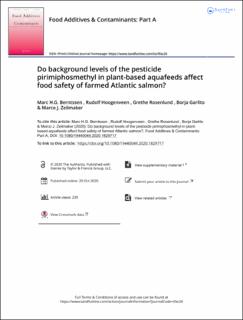| dc.description.abstract | The substitution of fish oil and fishmeal with plant-based ingredients in commercial aquafeeds for Atlantic salmon, may introduce novel contaminants that have not previously been associated with farmed fish. The organophosphate pesticide pirimiphos-methyl (PM) is one of the novel contaminants that is most prevalent in commercial salmon feed. In this study, the feed-to-fillet transfer of dietary PM and its main metabolites was investigated in Atlantic salmon fillet. Based on the experimental determined PM and metabolite uptake, metabolisation, and elimination kinetics, a physiologically based toxicokinetic (PBTK) compartmental model was developed. Fish fed PM had a relatively low (~4%) PM retention and two main metabolites (2-DAMP and Desethyl-PM) were identified in liver, muscle, kidney and bile. The absence of more metabolised forms of 2-DAMP and Desethyl-PM in Atlantic salmon indicates different metabolism in cold-water fish compared to previous studies on ruminants. The model was used to simulate the long term (>1.5 years) feed-to-fillet transfer of PM + metabolite in Atlantic salmon under realistic farming conditions including seasonal fluctuations in feed intake, growth, and fat deposition in muscle tissue. The model predictions show that with the constant presence of the highest observed PM concentration in commercial salmon feed, fillet PM+ metabolite levels were approximately 5 nmol kg−1, with highest levels for the metabolite 2-DAMP. No EU maximum residue levels (MRL) for PM and its main metabolites exist in seafood to date, but the predicted levels were lower than the MRL for PM in swine of 32.7 nmol kg−1. | en_US |
